Cold storage is a specialized facility where low temperatures are maintained to keep perishable goods fresh. Typically, frozen items are stored at -18°C to -25°C, while refrigerated goods are kept between 2°C and 8°C. These systems rely on advanced refrigeration technology, including compressors and sensors, to regulate temperature and humidity effectively. This helps extend shelf life, reduce spoilage, and enhance inventory management. However, cold storage can come with high operational costs. If you're curious about the specific techniques and maintenance practices that keep these systems running smoothly, there's more to discover.
Key Takeaways
- Cold storage refers to temperature-controlled environments used to preserve perishable goods by maintaining low temperatures, typically between -18°C to -25°C for frozen items.
- Advanced refrigeration systems are utilized in cold storage, featuring compressors, condensers, and microprocessor-based controls for precise temperature and humidity regulation.
- Effective cold storage enhances inventory management by extending the shelf life of products while minimizing spoilage and waste.
- Energy efficiency is crucial in cold storage operations, with energy consumption being a significant part of overall operational expenses.
- Regular maintenance practices are essential to ensure reliability and efficiency, involving daily, monthly, quarterly, and annual inspections.
Fundamental Principles of Cold Storage
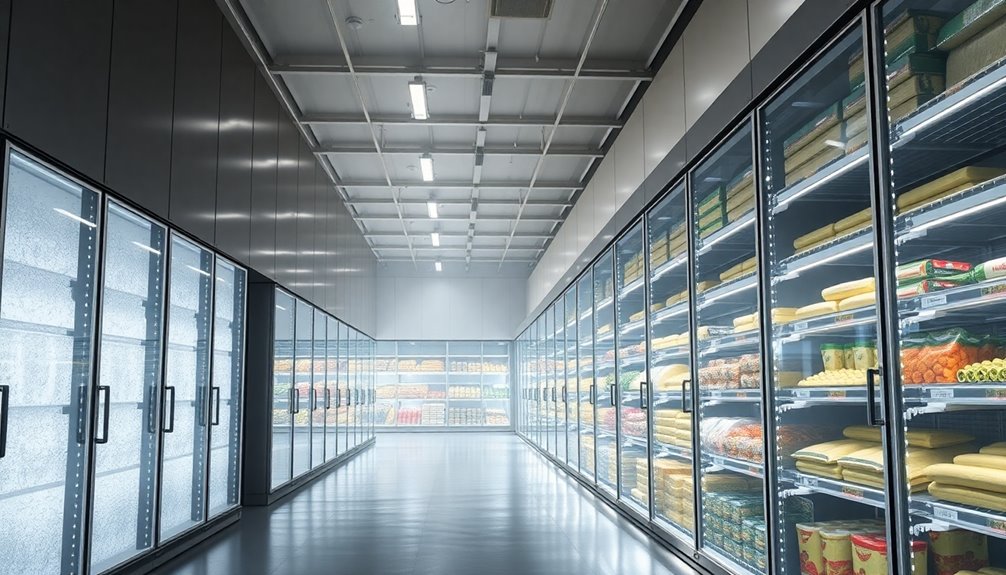
When it comes to cold storage, understanding the fundamental principles is vital for preserving perishable goods effectively.
You need to maintain consistent low temperatures, typically between -18°C and -25°C for frozen items and 2°C to 8°C for refrigerated goods. Advanced refrigeration systems with compressors, condensers, and evaporators help achieve these conditions.
Moreover, controlling humidity is essential to prevent mold and bacteria growth, and optimal levels vary by product type. Real-time monitoring systems track temperature and humidity, allowing immediate adjustments to maintain ideal conditions. Additionally, routine maintenance is crucial for ensuring that all equipment operates efficiently and effectively.
Alarms alert you to any deviations, ensuring swift resolutions to prevent spoilage.
Lastly, implementing strict safety measures and access control protects your inventory and staff, keeping everything in check.
Overview of Cold Storage Systems

Cold storage systems play a crucial role in preserving perishable goods, ensuring they remain safe and fresh for extended periods.
These systems comprise various components, including microprocessor-based control systems that adjust temperature and humidity based on sensor inputs. Electrical components like circuit breakers ensure safe power distribution, while refrigeration units, including compressors and condensers, maintain optimal cooling. With cold storage accounting for 3.6 billion cubic feet of warehouse space in 2017, you'll find several types of cold storage facilities, from bulk-stored options for large quantities to specialized setups for sensitive items like vaccines.
Effective temperature regulation, humidity control, and proper air circulation management are essential for maintaining product quality.
With safety features and energy-efficient technologies, these systems enhance the longevity of stored goods while complying with industry standards.
Cooling Techniques and Technologies
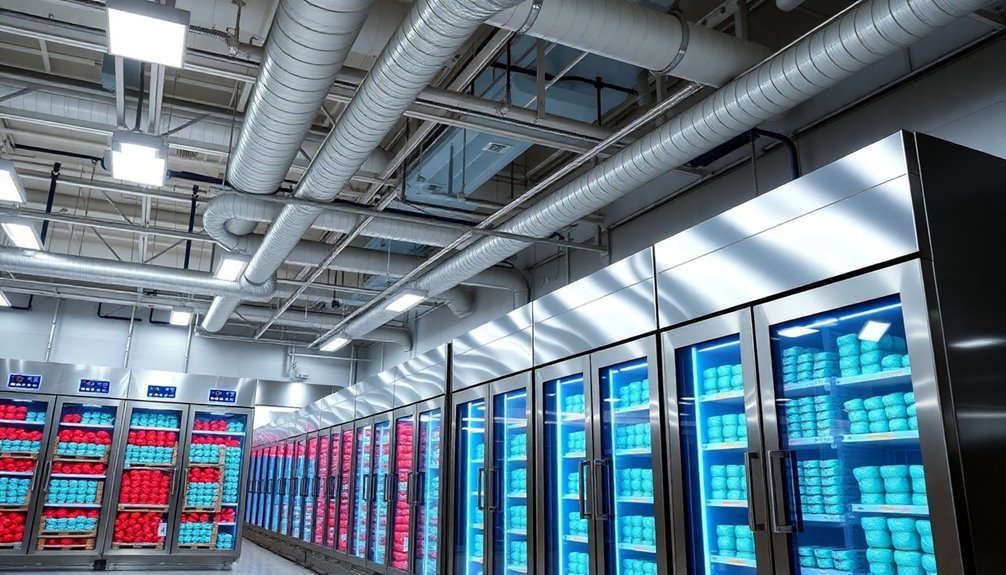
As you explore cold storage options, understanding the various cooling techniques and technologies can significantly enhance your facility's efficiency.
Advanced refrigeration systems utilize variable frequency drives to adjust cooling based on your goods' needs. Centralized parallel rack systems with multiple compressors and industrial chillers keep everything running smoothly.
Real-time monitoring through advanced sensors provides immediate temperature and humidity data, ensuring prompt adjustments when necessary. Automated systems respond to external conditions and stored goods, optimizing performance. In addition, maintaining the integrity of temperature-sensitive products is crucial for ensuring their quality and efficacy.
Additionally, specialized technologies like Phase Change Materials (PCMs) and cryogenic cooling allow for precise temperature control. Embracing natural refrigerants and energy-efficient compressors further reduces your carbon footprint while enhancing sustainability.
These innovations collectively contribute to a more efficient cold storage operation.
Pros and Cons Summary
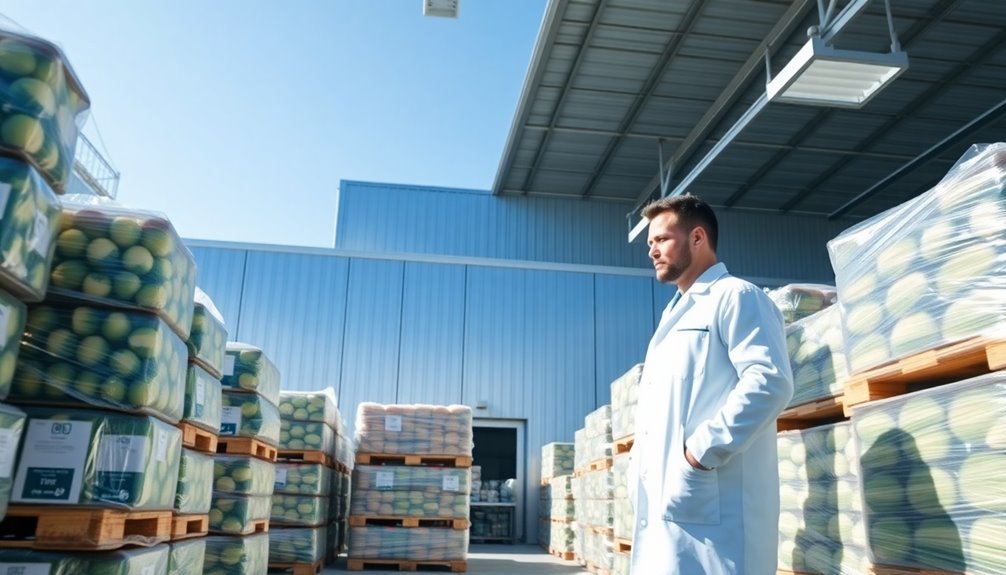
Understanding the pros and cons of cold storage is essential for making informed decisions about your facility.
On the plus side, cold storage extends the shelf life of perishable goods, maintains precise temperature control, and can be cost-effective by reducing spoilage. It also enhances inventory management and helps with data retention.
However, there are significant downsides. The operational costs can be high due to energy consumption, and initial investments for specialized equipment can be substantial. Additionally, temperature fluctuations from power outages pose risks, and regular maintenance can be time-consuming and costly. High operational costs can significantly impact overall business profitability, making it crucial to consider energy-efficient solutions.
Workers also face health and safety risks in cold environments, which necessitates strict safety protocols and equipment investments. Balancing these factors is key to effective cold storage management.
Cost Versus Efficiency Analysis

While evaluating the cost versus efficiency of cold storage, you'll find that energy consumption plays a pivotal role in overall operational expenses. With energy costs accounting for up to 18% of a company's total revenue, optimizing energy use is crucial. Implementing smart thermostats and energy-efficient equipment can significantly reduce energy consumption. High-density storage solutions and efficient facility layouts minimize wasted space and enhance operational efficiency. Additionally, continuous monitoring helps you identify deviations in energy usage, allowing for timely adjustments. By analyzing performance data and utilizing automation, you can further streamline operations, cutting labor costs while maintaining efficiency. Moreover, investing in energy-efficient systems can lead to substantial long-term savings. Ultimately, a well-planned cold storage facility balances energy costs with operational effectiveness, ensuring long-term profitability.
Temperature Fluctuation Vulnerabilities
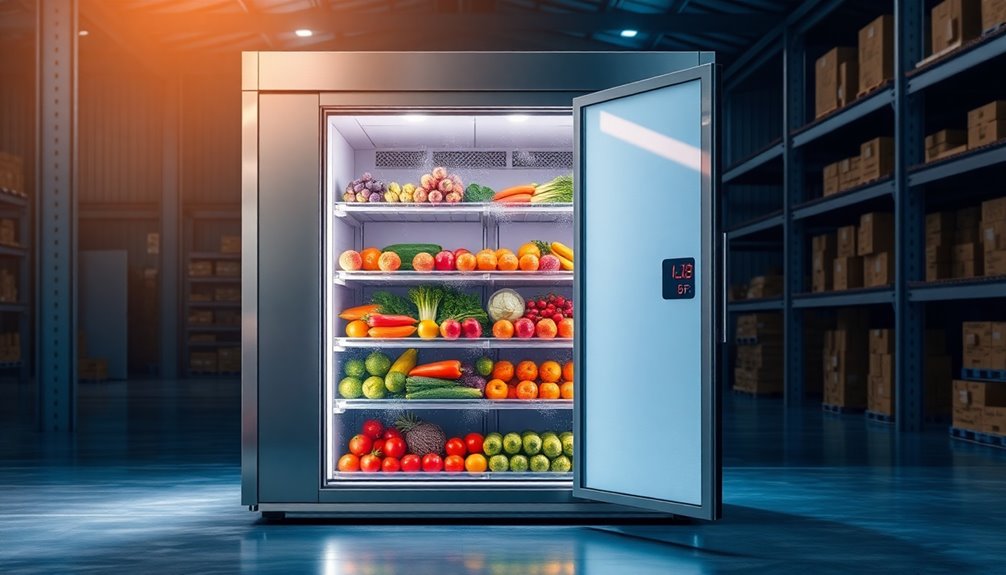
Energy efficiency is vital for cold storage operations, but it's equally important to address the vulnerabilities posed by temperature fluctuations.
Faulty equipment, power outages, and inadequate insulation can quickly lead to rising temperatures that jeopardize your products. Even minor deviations can cause spoilage, reduce nutritional value, and compromise safety by allowing pathogens to thrive. To combat these issues, consistent temperature monitoring is crucial, along with regular maintenance checks. Investing in backup power systems and redundant temperature control systems can minimize disruptions. Furthermore, implementing effective cold chain logistics can enhance the overall stability of temperature-sensitive products.
Developing effective risk management strategies and ensuring proper ventilation will help maintain product integrity. By addressing these vulnerabilities, you can protect your investments and ensure the longevity of your perishable goods.
Sustainable Energy Solutions in Cooling
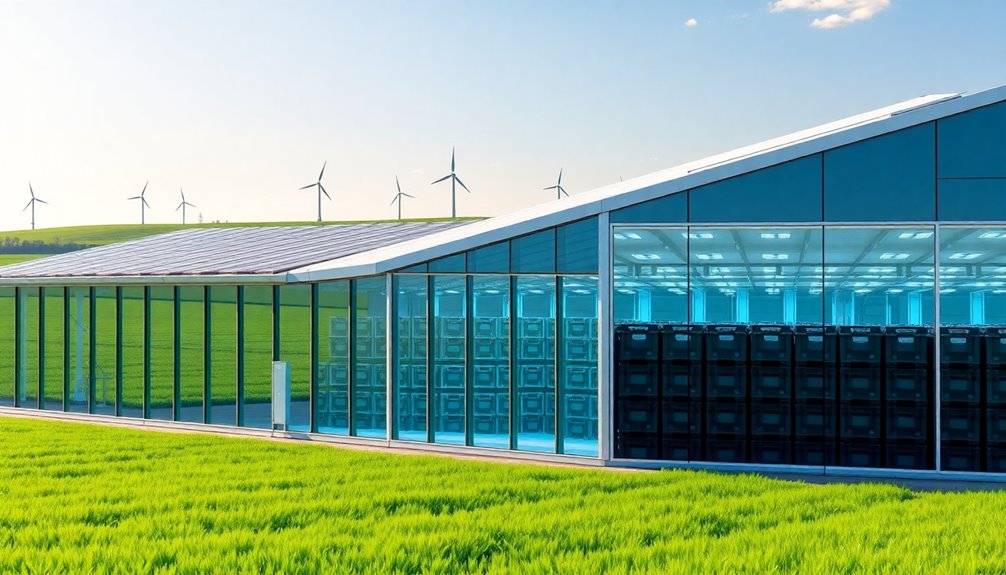
As the demand for sustainable practices grows, integrating renewable energy solutions into cold storage operations becomes essential. By adopting solar and wind power, you can significantly reduce your reliance on fossil fuels and lower your carbon footprint. Traditional cold chain logistics have a significant environmental footprint, and moving towards renewable sources not only addresses this issue but also aligns with global efforts to combat climate change.
Solar panels and wind turbines can seamlessly integrate into your facilities, aligning your operations with sustainability goals while cutting operational costs. Implementing energy-efficient technologies, like Thermal Energy Storage (TES) systems, can slash energy costs by up to 50%. Using natural refrigerants and advanced insulation further enhances efficiency. Additionally, IoT devices allow for real-time monitoring, ensuring optimal conditions and minimizing waste. With strategies like solar ice makers and eco-friendly refrigerants, you're not just cooling products—you're also contributing to a greener future.
Regular Maintenance Checks
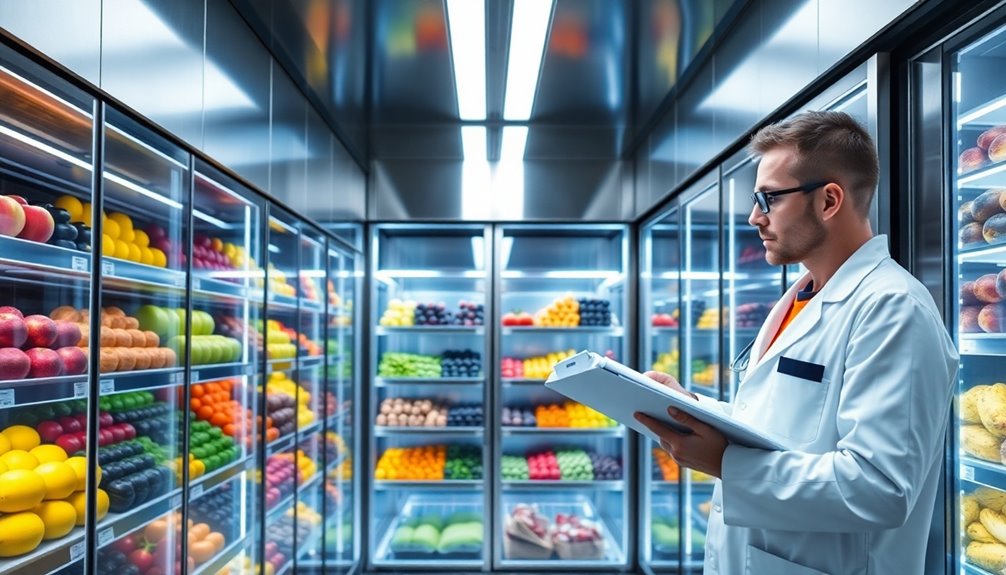
Regular maintenance checks are vital for keeping your cold storage systems running efficiently and reliably.
Start with daily checks: inspect compressors for oil leaks, monitor Freon levels, and assess the evaporator for ice formation. Ensure the PLC switchboard operates correctly and check the secondary system's head pressure.
Move on to monthly checks, cleaning condenser coil fins and verifying system efficiency. It's also important to conduct routine maintenance checks to ensure all components are functioning properly.
Every quarter, evaluate the functionality of cold rooms and clean evaporator casings.
Annually, conduct all previous checks, perform chemical washes on heat exchangers, and maintain compressors and electrical components.
Frequently Asked Questions
What Items Are Best Suited for Cold Storage?
When you think about items best suited for cold storage, consider dairy products like milk and cheese, as they need refrigeration to stay fresh.
Meats, including chicken and beef, also require cold conditions to prevent spoilage.
Don't forget seafood, which should be kept cold for freshness.
Fruits like berries and vegetables like celery thrive in cooler temperatures, while condiments like ketchup and mustard benefit from refrigeration to maintain quality.
How Long Can Food Be Kept in Cold Storage?
You can keep food in cold storage for varying lengths of time, depending on the type.
Fresh meat lasts up to three days, while poultry should be used within two days.
Most frozen foods stay good for months if stored at –18°C (0°F) or lower.
Remember, though, that certain fruits and vegetables have shorter shelf lives, so check them regularly to avoid spoilage and waste.
Always prioritize food safety for your health!
What Are Common Cold Storage Temperature Ranges?
Common cold storage temperature ranges vary based on what you're storing.
For frozen foods, aim for -18 to -22°F (-28 to -30°C).
If you're dealing with chilled items like dairy or fresh produce, keep temperatures between 35.6 to 39.2°F (2 to 4°C).
For pharmaceuticals, a range of 2 to 8°C (35.6 to 46.4°F) is crucial.
Maintaining these specific ranges helps ensure the quality and safety of your products.
What Are the Safety Regulations for Cold Storage Facilities?
Imagine a fortress built to withstand the chill of winter; that's what safety regulations in cold storage facilities ensure.
You need to wear warm, layered clothing and protective gear to shield against the cold.
Keep an eye out for slippery floors, and use anti-slip tape and signs to guide safe movement.
Regular equipment checks and adherence to OSHA guidelines help maintain a secure environment, protecting you from hazards while you work efficiently.
Can Cold Storage Be Used for Pharmaceuticals?
Yes, you can use cold storage for pharmaceuticals.
It's essential for preserving the efficacy and safety of temperature-sensitive medications and vaccines. By maintaining specific temperature ranges, you keep products stable, prevent contamination, and extend their shelf life.
Additionally, proper cold storage helps you meet regulatory requirements, ensuring compliance with health standards.
When effectively managed, cold storage supports emergency preparedness, allowing for quick access to critical medications during public health crises.
Conclusion
In summary, understanding cold storage is crucial for anyone involved in food preservation or sensitive material storage. By grasping the fundamental principles and the various systems available, you can make informed decisions that balance cost and efficiency. With the right maintenance and sustainable practices, you can minimize temperature fluctuations and their risks. So, isn't it worth investing in reliable cold storage solutions to protect your valuable resources? Start optimizing your approach today!









